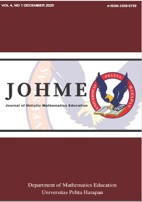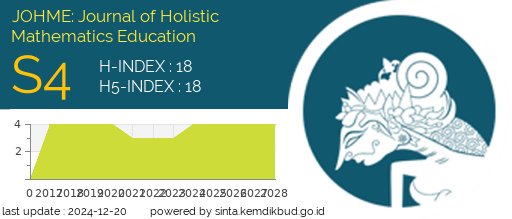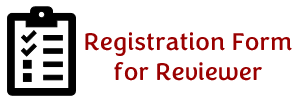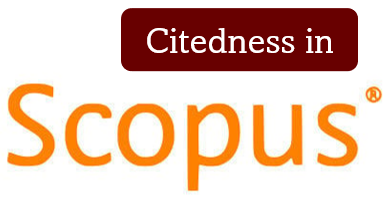KEYAKINAN MATEMATIS DAN KEMANDIRIAN BELAJAR MAHASISWA PADA PROGRAM STUDI PENDIDIKAN MATEMATIKA [MATHEMATICAL BELIEFS AND THE SELF-REGULATED LEARNING OF STUDENTS IN A MATHEMATICS EDUCATION STUDY PROGRAM]
DOI:
https://doi.org/10.19166/johme.v4i1.2637Λέξεις-κλειδιά:
mathematical beliefs, self-regulated learning, mathematics prior knowledge, keyakinan matematis, kemandirian belajar, pengetahuan awal matematisΠερίληψη
In general, integral calculus courses are difficult for students because the problems involved require strong problem-solving skills. For university students, integral calculus courses also require them to do self-regulated, or independent, learning. Another aspect that makes learning difficult for these students is their mathematical beliefs and prior knowledge. This study aims to see how different types of mathematical beliefs affect self-regulated learning in terms of students' prior knowledge. This research was conducted on students in a mathematics education study program at a private university in Tangerang with a sample of 120 students. This research is an ex post facto quantitative study using a two factorial design. The variables in this study consisted of independent variables in the form of mathematical beliefs, the moderator variable in the form of students’ prior knowledge, and the dependent variable in the form of self-regulated learning. The results obtained are: (1) self-regulated learning by students with logical consistency mathematical beliefs is higher than students with memorized and procedural beliefs, (2) there is an interaction between mathematical beliefs and prior knowledge towards self-regulated learning, (3) student in the high prior knowledge gorup logical consistency beliefs had higher self-regulated learning than students with memorized and procedural beliefs, and (4) self-regulated learning in the low mathematics prior knowledge group with logical consistency beliefs is lower than students with memorized and procedural beliefs.
BAHASA INDONESIA ABSTRACT: Mata kuliah kalkulus integral pada umumnya masih menjadi kesulitan bagi mahasiswa karena permasalahan yang terkandung membutuhkan pemecahan masalah yang kuat. Kalkulus integral juga membutuhkan kemandirian belajar bagi mahasiswa yang mempelajarinya. Hal lain yang menjadi kesulitan mahasiswa adalah faktor keyakinan matematis dan pengetahuan awal matematis. Penelitian ini bertujuan untuk melihat perbedaan jenis keyakinan matematis terhadap kemandirian belajar mahasiswa ditinjau dari pengetahuan awal matematisnya. Penelitian ini dilakukan terhadap mahasiswa program studi pendidikan Matematika pada salah satu universitas swasta di Tangerang dengan sampel yang digunakan sebanyak 120 orang. Penelitian ini merupakan penelitian kuantitatif ex post facto dengan menggunakan desain dua faktorial. Variabel pada penelitian ini terdiri dari variabel bebas berupa keyakinan matematis, variabel moderator berupa pengetahuan awal matematis, dan variabel terikat berupa kemandirian belajar. Hasil penelitian yang didapatkan adalah: (1) mahasiswa dengan keyakinan logical consistency memiliki kemandirian belajar lebih tinggi daripada mahasiswa dengan keyakinan hafalan dan prosedural, (2) terdapat interaksi antara keyakinan matematis dan pengetahuan awal matematis (PAM) terhadap kemandirian belajar mahasiswa, (3) mahasiswa pada kelompok PAM tinggi dengan keyakinan logical consistency memiliki kemandirian belajar lebih tinggi daripada mahasiswa dengan keyakinan hafalan dan prosedural, dan (4) mahasiswa pada kelompok PAM rendah dengan keyakinan logical consistency memiliki kemandirian belajar lebih rendah daripada mahasiswa dengan keyakinan hafalan dan prosedural.
Αναφορές
Ana, & Achdiani, Y. (2017). Penerapan self regulated learning berbasis internet untuk meningkatkan kemandirian belajar mahasiswa. Innovation of Vocational Technology Education, 11(1), 15-22. https://doi.org/10.17509/invotec.v11i1.4835
Bien, Y. I., Daniel, F., & Taneo, P. N. (2018). Kalkulus integral berbasis Maple. Yogyakarta, Indonesia: Deepublish.
Chiu, M. S. (2012). Identification and assesment of Taiwanese children’s conceptions of learning mathematics. International Journal of Science and Mathematics Education, 10(1), 163-191. https://doi.org/10.1007/s10763-011-9283-2
Czocher, J. A., & Moss, D. L. (2017). Mathematical modeling: Are prior experiences important? The Mathematics Teacher, 110(9), 654-662. https://doi.org/10.5951/mathteacher.110.9.0654
Gilmore, C., Keeble, S., Richardson, S., & Cragg, L. (2017). The interaction of procedural skill, conceptual understanding and working memory in early mathematics achievement. Journal of Numerical Cognition, 3(2), 400-416. https://doi.org/10.5964/jnc.v3i2.51
Hailikari, T. (2009). Assessing university students’ prior knowledge: Implications for theory and practice. Helsinki, Finland: University of Helsinki Department of Education. Retrieved from https://core.ac.uk/download/pdf/14915392.pdf
Harding, S. M., English, N., & Nibali, N. (2019). Self-regulated learning as a predictor of mathematics and reading performance: A picture of students in Grades 5 to 8. Australian Journal of Education, 63(1), 74-97. https://doi.org/10.1177/0004944119830153
Johnson, B. R., Siegler, R. S., & Alibali, M. W. (2001). Developing conceptual understanding and procedural skill in mathematics: An iterative process. Journal of Educational Psychology, 93(2), 346-362. https://doi.org/10.1037/0022-0663.93.2.346
Kramarski, B., & Revach, T. (2009). The challenge of self-regulated learning in mathematics teachers' professional training. Educational Studies in Mathematics, 72(3), 379-399. https://doi.org/10.1007/s10649-009-9204-2
Maharani, R. (2019). Perbedaan tingkat kecemasan matematika, kecerdasan matematis logis, dan kecerdasan spiritual terhadap penyelesaian pembuktian matematika. Factor M: Focus Action of Research Mathematic, 1(2), 90-105. https://doi.org/10.30762/f_m.v1i2.1308
Mahir, N. (2009). Conceptual and procedural performance of undergraduate students in integration. International Journal of Mathematical Education in Science and Technology, 40(2), 201-211. https://doi.org/10.1080/00207390802213591
Mason, J. (2004). Are beliefs believable? Mathematical Thinking and Learning, 6(3), 343-352. https://doi.org/10.1207/s15327833mtl0603_4
Mulyana, A., & Sumarmo, U. (2015). Meningkatkan kemampuan penalaran matematik dan kemandirian belajar siswa SMP melalui pembelajaran berbasis masalah. Didaktik, 9(1), 40-51. Retrieved from http://e-journal.stkipsiliwangi.ac.id/index.php/didaktik/article/view/116
Murti, E. D., Nasir, & Negara, H. S. (2019). Analisis kemampuan pemecahan masalah matematis: Dampak model pembelajaran SAVI ditinjau dari kemandirian belajar matematis. Desimal: Jurnal Matematika, 2(2), 119-129. https://doi.org/10.24042/djm.v2i2.4072
Musfah, J. (2015). Manajemen pendidikan: Teori, kebijakan, dan praktik. Jakarta, Indonesia: PT Fajar Interpratama Mandiri.
Neber, H., He, J., Liu, B. X., & Schofield, N. (2008). Chinese high-school students in physics classroom as active, self-regulated learners: Cognitive, motivational and environmental aspects. International Journal of Science and Mathematics Education, 6(4), 769-788. https://doi.org/10.1007/s10763-007-9110-y
Nursyahidah, F., & Albab, I. U. (2018). Identifikasi kemampuan berpikir kritis matematis mahasiswa berkemampuan pemecahan masalah level rendah dalam pembelajaran kalkulus integral berbasis problem based learning. Jurnal Elemen, 4(1), 34-49. https://doi.org/10.29408/jel.v4i1.513
Ozturk, T., & Guven, B. (2016). Evaluating students’ beliefs in problem solving process: A case study. Eurasia: Journal of Mathematics, Science & Technology Education, 12(2), 411-429. https://doi.org/10.12973/eurasia.2016.1208a
Pamungkas, A. S., Setiani, Y., & Pujiastuti, H. (2017). Peranan pengetahuan awal dan self esteem matematis terhadap kemampuan berpikir logis mahasiswa. Kreano: Jurnal Matematika Kreatif-Inovatif, 8(1), 61-68. https://doi.org/10.15294/kreano.v8i1.7866
Parma, & Saparwadi, L. (2015). Pengembangan model pembelajaran kalkulus berbantuan komputer melalui program Maple di program studi pendidikan matematika. Jurnal Elemen, 1(1), 37-48. https://doi.org/10.29408/jel.v1i1.80
Qohar, A., & Sumarmo, U. (2013). Improving mathematical communication ability and self regulation learning of Yunior High Students by using reciprocal teaching. Journal on Mathematics Education, 4(1), 59-74. https://doi.org/10.22342/jme.4.1.562.59-74
Rahmatan, H., & Liliasari. (2012). Pengetahuan awal calon guru Biologi tentang konsep katabolisme karbohidrat (respirasi seluler). Jurnal Pendidikan IPA Indonesia, 1(1), 91-97. Retrieved from https://journal.unnes.ac.id/nju/index.php/jpii/article/view/2019/2133
Samo, D. D. (2016). An analysiso of self-regulated learning on mathematics education student FKIP Undana. Infinity Journal, 5(2), 67-74. https://doi.org/10.22460/infinity.v5i2.213
Shuy, T. (2010). TEAL Center Fact Sheet No. 3: Self-Regulated Learning. Retrieved from https://lincs.ed.gov/sites/default/files/3_TEAL_Self%20Reg%20Learning.pdf
Sriyanto, H. J. (2017). Mengobarkan api matematika. Sukabumi, Indonesia: CV Jejak.
Sudarwo, R., Yusuf, & Anfas. (2018). Pengaruh sarana belajar dan motivasi belajar terhadap kemandirian belajar mahasiswa (Studi Empirical Pada Mahasiswa Beasiswa Bidikmisi UPBJJ-UT Ternate). Jurnal Pendidikan, 19(2), 68-83. https://doi.org/10.33830/jp.v19i2.152.2018
Suherman, E. (2003). Strategi pembelajaran matematika kontemporer. Bandung, Indonesia: Universitas Pendidikan Indonesia
Sun, Z., Xie, K., & Anderman, L. H. (2018). The role of self-regulated learning in students' success in flipped undergraduate math courses. The Internet and Higher Education, 36(1), 41-53. https://doi.org/10.1016/j.iheduc.2017.09.003
Supardi. (2015). Peran kedisiplinan belajar dan kecerdasan matematis logis dalam pembelajaran matematika. Formatif: Jurnal Ilmiah Pendidikan MIPA, 4(2), 80-88. https://doi.org/10.30998/formatif.v4i2.142
Thamsir, T., Silalahi, D. W., & Soesanto, R. H. (2019). Upaya meningkatkan kemampuan pemecahan masalah soal non-rutin pada materi persamaan dan pertidaksamaan linear satu variabel dengan penerapan metode peer tutoring [Efforts in improving mathematical problem-solving skills of non-routine problems of one-variable linear equations and inequalities by implementing the peer tutoring method]. JOHME: Journal of Holistic Mathematics Education, 3(1), 96-107. https://doi.org/10.19166/johme.v3i1.927
Tsai, C. C., & Huang, C. M. (2002). Exploring students' cognitive structures in learning science: A review of relevant methods. Journal of Biological Education, 36(4), 163-169. https://doi.org/10.1080/00219266.2002.9655827
Turmudi. (2010). Metodologi pembelajaran matematika: Pelatihan guru-guru di Manokwari Papua Barat. Bandung, Indonesia: Universitas Pendidikan Indonesia. Retrieved from http://file.upi.edu/Direktori/FPMIPA/JUR._PEND._MATEMATIKA/196101121987031-TURMUDI/F25-Metodologi_dan_Model_PembelajaranMatematika.pdf
Viholainen, A., Asikainen, M., & Hirvonen, P. E. (2017). Mathematics student teachers’ epistemological beliefs about the nature of mathematics and the goals of mathematics teaching and learning in the beginning of their studies. EURASIA: Journal of Mathematics, Science and Technology Education, 10(2). https://doi.org/10.12973/eurasia.2014.1028a
Wolters, C. A. (2003). Assesing academic self-regulated learning. Ann Arbor, MI: University of Michigan
Yıldızlı, H., & Saban, A. (2016). The effect of self-regulated learning on sixth-grade Turkish students’ mathematics achievements and motivational beliefs. Cogent Education, 3(1), 1-17. https://doi.org/10.1080/2331186x.2016.1212456
Zimmerman, B. J. (2015). Self-regulated learning: Theories, measures, and outcomes. International Encyclopedia of the Social & Behavioral Sciences, 541-546. https://doi.org/10.1016/b978-0-08-097086-8.26060-1Λήψεις
Δημοσιευμένα
Πώς να δημιουργήσετε Αναφορές
Τεύχος
Ενότητα
Άδεια
Authors who publish with this journal agree to the following terms:
1) Authors retain copyright and grant the journal right of first publication with the work simultaneously licensed under a Creative Commons Attribution License (CC-BY-SA 4.0) that allows others to share the work with an acknowledgement of the work's authorship and initial publication in this journal.
2) Authors are able to enter into separate, additional contractual arrangements for the non-exclusive distribution of the journal's published version of the work (e.g., post it to an institutional repository or publish it in a book), with an acknowledgement of its initial publication in this journal.
3) Authors are permitted and encouraged to post their work online (e.g., in institutional repositories or on their website). The final published PDF should be used and bibliographic details that credit the publication in this journal should be included.”










